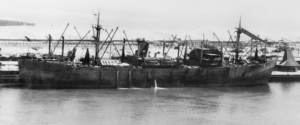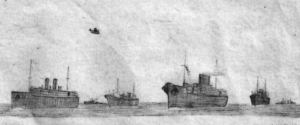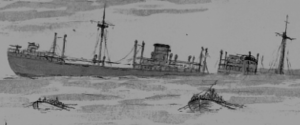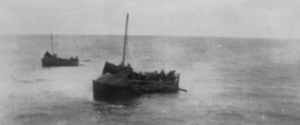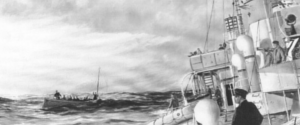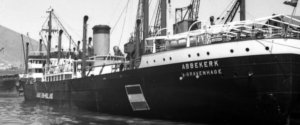HrMs Soemba again: do you have beer?!

14 May 1942. Abbekerk finally leaves Colombo setting course for the Persian Gulf. Because they unloaded some of the wheat cargo she is not as deep in the water any more. Without a problem 17 knots cruising speed is met and soon the crew fall back into the working routine. As she approaches the entrance of the Persian Gulf the weather is sunny and windless. The water as flat as a pancake and the temperature rising fast. Only the speed of the ship delivers a small breeze. As they pass through the Strait of Hormuz the sea around the ship is empty. At 11.30 A.M. the lookout cries from the crow’s nest: ‘Ship in sight. A warship !’
 On the bridge 3rd mate Visser grabs a pair of binoculars en recognizes the ship almost instantly. It is the familiar ‘ floating flat iron ‘ silhouette of a small Dutch marine vessel. He calls out to the Captain:
On the bridge 3rd mate Visser grabs a pair of binoculars en recognizes the ship almost instantly. It is the familiar ‘ floating flat iron ‘ silhouette of a small Dutch marine vessel. He calls out to the Captain:
‘Captain, there’s is a small warship approaching and I think it’s the Soemba !’
Yes it was the gunboat Hr Ms Soemba, the Japs didn’t get her either! As soon as she recognised us the signal lamp got working. First to welcome us and then without further ado they asked “Have you still got any BEER?”
Ass. engineer Adriaan Kik
At Oosthaven, 3 months earlier, it became apparent that Captain Wijker and the Commander of the Soemba had become good friends and that there developed a special relationship between the crews of the two ships. But what happened next stunned almost everyone.
And so we prepared to stop. Don’t forget, this was the middle of wartime at the entrance of the Persian Gulf, which is quite wide at that point. Enemy submarines could be anywhere. But we ordered the engine room to prepare to stop.
Third mate Jacob Visser
This takes about half an hour as the engines, when running at cruising speed, get very hot and are cooled by cold seawater. So we gradually slow down the engines to an acceptable temperature so we could maneuver without doing any damage. The Captain sympathized with the crew on the Soemba, particularly with the plates of spicy nasi-goring and other delicious dishes. Pea and Ham soup was served on our ship in tropical heat as well as in artic cold. In this situation The Royal Dutch Navy was without the required quenching water which was nothing short of a culinary disaster. A good number of crates of beer was brought out of our cold room and stacked on deck on the leeward side of the ship
Ass. engineer Adriaan Kik
Gangway down, the commander of the Soemba approached us in a little rowboat with a sailor rowing. The small vessel was secured to the gangway and the commander went for a drink with our captain. The engines were put in slow ahead. But that still is about 9 knots.
Third mate Jacob Visser
Of course it is logical that the ship kept moving. Although no Japanese were sighted, a submarine may always be present and a non-moving vessel is a sitting duck.
I could see what was about to happen: The rope was a little too long, pulling the bow of the little boat lower in the water. The sailor went up front to shorten the rope but with the shift in weight the bow went right under water and with the moving of our ship filling the whole boat. The sailor desperately hung on to the rope. Luckily an officer on the bridge was looking down and rang the telegraph to stop the ship. The sailor was immediately pulled on to the gangway but the rope tied to the dinghy broke and down went the little boat.
Ass. engineer Adriaan Kik
As the two commanders eat and drink the ships sail on together. But this does mean Abbekerk has to slow down for the Soemba to keep up.
Later that night, around ten o’clock the party was over and the commander decided to head back to the Soemba. We stopped, lowered our motorized lifeboat (loaded with crates of beer) to the water – I was commander of the lifeboat – and put it alongside the gangway. Commander boarded and we set of to the Soemba. There we delivered the commander and returned to the Abbekerk.
Third mate Jacob VisserAfter the lifeboat’s return it was hoisted back into the davits, the telegraph was put on full speed ahead and that was the last we saw of the Soemba. Nevertheless the regard the Royal Navy and the Merchant Marine had for each other was kept intact. Ha, Ha, Ha.
The trip through the Persian golf ran like clockwork with increasingly higher temperatures. The only occasion of any note occurred while I was looking overboard and I saw all of a sudden an enormously large sting ray, a manta ray I thought, that was swimming alongside the ship. A big one with a diameter of at least two and a half metres, which slowly and graciously moved the end of her- let’s call them ‘wings’ trying to keep up with the ship. It was a really beautiful and memorable sight
Ass. engineer Adriaan Kik

